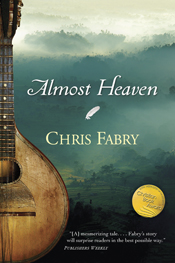Reviewed by Phee Paradise
Red Ink
By Kathi Macias
When you read Red Ink, you get two completely unrelated stories – almost. Yeng Zhen Li is a Chinese Christian who is incarcerated for her faith during the Cultural Revolution. Julia is a widow living in a retirement home in California who is compelled to pray for China, and especially for one woman whose name she doesn’t know. Except for the prayer connection, and a theme of Christian faithfulness, the two stories are completely unrelated.
Zhen Li was taken from her husband and young son because she told the children of her village about Jesus, which was illegal. She continues to share her faith in prison, even though it results in beatings. Her story revolves around her cellmate, Mei, who spies on her, and an evil guard who enjoys torturing her and is determined to break her. Meanwhile, her husband, his sister, and her mother must all confront the God that Zhen Li is so devoted to.
Julia moved to a small retirement home after her husband died and is learning to serve God in new ways as her body ages. She spends a lot of time in prayer with a friend in the home, but struggles with her dislike of another resident. The more she prays, the more urgent her concerns for China become. But she also has prayer concerns closer to home. The Lord lays Maggie, the granddaughter of her nemesis, on Julia’s heart. Maggie is taking drugs and is drawn into a dangerous world she doesn’t understand.
I’ve never been able to read more than one book at a time. I like becoming absorbed in one fictional world at a time. So Red Ink was hard for me to read. It keeps jumping from China to California and it really felt like I was reading two books. This was exacerbated by short, multiple point of view changes, which occur on nearly every page. In China, we get the story from all the involved characters, including Zhen Li’s family, her cellmate and even the guard who torments her. In California, we not only see Julia’s point of view, but that of Maggie and some of the people in her drug-hazed world. All of this made it hard for me to become involved with any of the people in the book, even Zhen Li and Julia, who are heroes of the faith. In fact, Maggie’s story was the one I found most absorbing.
Having said that, I need to point out the strengths of the book as well. Both settings are described well, especially the bleak world of Red China. The lack of hope and purpose in the people who don’t know Jesus is heartbreaking. Knowing that a whole nation is in that condition makes you want to join Julia in prayer. That same lack of hope is portrayed in the retirement home in California as well, but in both places, the love of God and faithfulness of His children overcome it. Both stories are about the triumph of faith and faithfulness.
Pros: Strong stories about how God answers prayers for protection and about the faithfulness of His people. Realistic descriptions of an awful time in the history of China and the people who lived it.
Cons: Too many changes in the stories and too many points of view.
About the book
 A young Chinese woman, Zhen-Li—raised to observe the party line, including its one-child-per-family doctrine—falls in love with and marries a Christian, and adopts his faith. Though the couple downplays their Christianity in an effort to survive, Zhen-Li’s family is appalled, and she and her husband are ostracized. When she becomes pregnant for the second time and refuses to have an abortion, the persecution begins in earnest. Zhen-Li’s parents, under pressure from the government, pay to have Zhen-Li kidnapped and the baby aborted.
A young Chinese woman, Zhen-Li—raised to observe the party line, including its one-child-per-family doctrine—falls in love with and marries a Christian, and adopts his faith. Though the couple downplays their Christianity in an effort to survive, Zhen-Li’s family is appalled, and she and her husband are ostracized. When she becomes pregnant for the second time and refuses to have an abortion, the persecution begins in earnest. Zhen-Li’s parents, under pressure from the government, pay to have Zhen-Li kidnapped and the baby aborted.
It is then Zhen-Li decides she must live up to her name—"Truth"—and take a firm stand for her faith, regardless of the consequences, and so she begins to regularly teach children about Zhu Yesu ("Lord Jesus") and to distribute Christian literature every chance she gets.
Based loosely on the life of Christian magazine editor Li Ying, currently serving a ten-year prison sentence in China, the story of Yang Zhen-Li tells the desperate tale of her incarceration and separation from her family, as she continues to minister to other prisoners, and even to her guards.
About the author
 Kathi is a multi-award winning writer who has authored nearly 30 books and ghostwritten several others. A former newspaper columnist and string reporter, Kathi has taught creative and business writing in various venues and has been a guest on many radio and television programs. Kathi is a popular speaker at churches, women’s clubs and retreats, and writers’ conferences, and recently won the prestigious 2008 member of the year award from AWSA (Advanced Writers and Speakers Association) at the annual Golden Scrolls award banquet. Kathi “Easy Writer” Macias lives in Homeland, CA, with her husband, Al, where the two of them spend their free time riding their Harley.
Kathi is a multi-award winning writer who has authored nearly 30 books and ghostwritten several others. A former newspaper columnist and string reporter, Kathi has taught creative and business writing in various venues and has been a guest on many radio and television programs. Kathi is a popular speaker at churches, women’s clubs and retreats, and writers’ conferences, and recently won the prestigious 2008 member of the year award from AWSA (Advanced Writers and Speakers Association) at the annual Golden Scrolls award banquet. Kathi “Easy Writer” Macias lives in Homeland, CA, with her husband, Al, where the two of them spend their free time riding their Harley.
Interview with the author
Red Ink is the third book in your four-book Extreme Devotion series. Each book is set in a different country, with the theme of first devotion and commitment to Christ above all else running through all four. How is Red Ink different, and who/what inspired you to write this book?
Red Ink is the only one of the four books that actually deals with someone being arrested and suffering specifically for her faith in Christ. The story is loosely based on my own personal heroine, Li Ying, who is currently serving a ten-year sentence in China for printing/distributing Christian materials, particularly to children. I pray for Li Ying daily, and I remind myself how very blessed I am to have the freedom to do what she did—without paying the price she now pays.
Can you give us a brief synopsis of this story?
A young Chinese woman, Zhen-Li—raised to observe the party line, including its one-child-per-family doctrine—falls in love with and marries a Christian, and adopts his faith. Though the couple downplays their Christianity in an effort to survive, Zhen-Li’s family is appalled, and she and her husband are ostracized. When she becomes pregnant for the second time and refuses to have an abortion, the persecution begins in earnest. Zhen-Li’s parents, under pressure from the government, pay to have Zhen-Li kidnapped and the baby aborted.
It is then Zhen-Li decides she must live up to her name—"Truth"—and take a firm stand for her faith, regardless of the consequences, and so she begins to regularly teach children about Zhu Yesu ("Lord Jesus") and to distribute Christian literature every chance she gets. Based loosely on the life of Christian magazine editor Li Ying, currently serving a ten-year prison sentence in China, the story of Yang Zhen-Li tells the desperate tale of her incarceration and separation from her family, as she continues to minister to other prisoners, and even to her guards, leading to a surprising conclusion that will both stun and challenge readers.
How did you get into writing? Has it always been your passion, or is it something you came to later in life?
I’ve always wanted to write, for as long as I can remember. I was an avid reader even before I started kindergarten. I wrote a short story in third grade that the teacher liked so much she showed it to the principal, and they decided to turn it into a play for the entire PTA. I was hooked! One day when I was about 13, I was walking home from school with my then boyfriend (now husband), Al, and I told him I’d be a writer some day. He often reminds me how blessed I am to have been able to do what I dreamed of all my life.
I understand you’re running a special contest that has to do with this book. Can you tell us about it?
Actually, I’m running the same contest twice—two chances to win a free Kindle! To be eligible, follow these three steps:
* You have to read Red Ink and post reviews on Amazon, CBD, etc., and/or your personal blog;
* You must also be a follower of my Easy Writer blog (address below); and,
* Let me know via my website contact email: mailto:ezyrtr@ca.rr.com that you have met the requirements and want to be entered.
The first winner will be announced in early November; the second in mid-December, just in time for a last-minute Christmas gift.
In addition to writing, you are a popular speaker at women’s event, writers’ conferences, and various venues around the country. How can people find out more about you, your writing and speaking, sign up for your weekly devotional newsletter (in English or Spanish), and/or just view your many book videos, etc.?
They can find me at my website (http://www.kathimacias.com) or blog (http://kathieasywritermacias.blogspot.com). There is a “contact” button on my website if they’d like to send me a message. I always respond to all my emails!
A complimentary copy of this book was provided to me as a blog tour host by New Hope Publishers in exchange for posting this interview on my blog. Please visit Christian Speaker Services at www.ChristianSpeakerServices.com for more information about blog tour management services.




























































